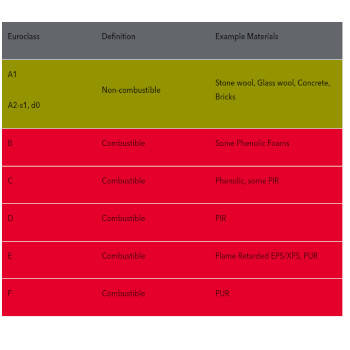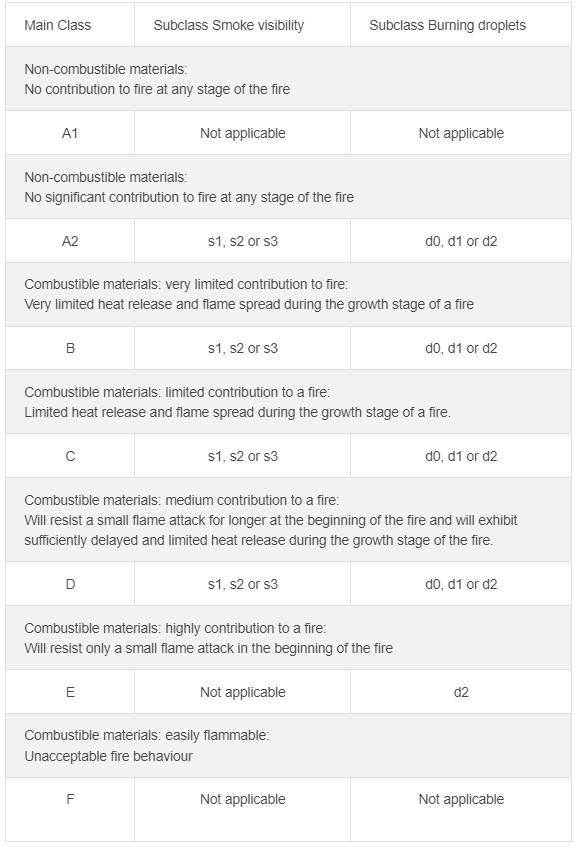
UK FIRE RATING EXPLAINED IN 125 SECONDS*
Ensuring fire safety in building construction is of paramount importance, and adherence to British Standards for Fire Protection is a crucial aspect. When it comes to selecting insulating materials, strict criteria must be met. In buildings exceeding 18 metres in height, only materials with A1 and A2 fire ratings can be specified. This requirement stems from the non-combustible nature of A1 and A2-rated materials, providing enhanced fire resistance and safeguarding occupants in case of a fire incident. Join us as we delve deeper into the significance of these fire ratings and their essential role in promoting fire safety in buildings.
WHAT FIRE RATING IS INSULATION? / FIRE RATING CLASSIFICATIONS UK
Insulation materials are named into 3 groups based on their fire properties. The first letter ‘A1-F’ (group) denotes their combustibility and contribution to fire, the second letter ‘s’ (group) refers to the level of Smoke propagation and the third letter ’d’(group) indicates the presence of flaming Droplets in the first 10 minutes.
First group classifications range from A1 to F, with A1 being the highest and most superior level of fire resistance, D range from very limited to medium contribution to fire. Materials in Class E and F have a high contribution to fire and are easily flammable.

FIRST LETTER-Combustibility and Contribution to fire
A1, A2, B, C, D, E and F
SECOND LETTER-Smoke propagation or emission
s1,s2,s3
The 's' (group) component of the fire rating system refers to the level of smoke propagation or emission, which is rated from 1 (absent/weak) to 3 (high):
s1: Indicates minimal or no smoke emission.
s2: Represents a considerable amount of smoke.
s3: Signifies substantial smoke production.
Picture credit:rockwool.com
THIRD LETTER - Droplets and particles
d0, d1, d3
Additionally, the 'd' (group) part of the rating indicates the presence of 'flaming droplets and particles' during the first 10 minutes of exposure. The index is as follows:
d0: Indicates the absence of flaming droplets and particles.
d1: Represents some presence of flaming droplets and particles.
d2: Signifies a significant amount of flaming droplets and particles.

Picture credit:rockpanel.co.uk
WHAT IS THE CLASS A1 FIRE RATING OF INSULATION?
Fire rated insulation is a completely non-combustible product, does not require any additional safety tests as it cannot contribute to fire, including fully developed fire scenarios.
*Examples of fire-rated materials that are completely non-combustible, as they cannot contribute to fire, even under fully developed scenarios, include:
ROCKWOOL RW STONE WOOL
RWA45, RW3, RW5, EXTERNAL WALL DD INSULATION SLAB
KNAUF RS RANGE
RS45, RS60, RS100
If these materials have not undergone any form of treatment, such as coatings or modifications, they retain their A-rating.
WHAT IS THE DIFFERENCE BETWEEN A1 AND A2 FIRE RATINGS?
The main difference between A1 and A2 fire ratings lies in their level of combustibility and contribution to fire. A1 materials exhibit full non-combustibility, ensuring they do not contribute to fire in any way. On the other hand, A2 materials possess limited combustibility, meaning they have a minor potential to contribute to fire under specific conditions.
Due to A1 products' complete non-combustibility, those products are exempt from undergoing any additional safety tests.
CONCLUSION
In conclusion, understanding fire ratings for insulation materials is crucial for ensuring optimal fire safety in construction projects. The A1, A2, B, C, D, E, and F classifications provide valuable insights into the combustibility and contribution to fire of different materials. By selecting the appropriate fire-rated insulation, builders and designers can enhance the overall safety of buildings and protect occupants in the event of a fire. Always prioritise the highest fire-resistant materials for critical areas to minimise fire risks and create a secure environment for everyone.
Related articles:
UNLEASHING THE POWER OF 30-MINUTE FIRE BOARDS
FIRE RATED & NON-CORROSIVE WASHERS: SAFETY AND DURABILITY UNVEILED
THE ULTIMATE GUIDE TO 30-60-90-240 MINUTE A1 FIRE RATED BOARDS: BENEFITS AND APPLICATIONS
Bibliography:
1.rockwool.com, Building regulations, ‘Euroclass system’, accessed 18 July 2023,
*All the information provided in the content published on Insulationgo blog is for informational and educational purposes only. Insulationgo LTD makes every effort to ensure the accuracy and timeliness of the content, but we do not assume any responsibility for any errors or omissions.
The information presented on this blog should not be considered as professional advice or a substitute for consulting relevant experts. Before making any purchase decisions or taking action based on the information presented here, it is strongly recommended to contact the product manufacturer directly to verify the details and ensure its suitability for your specific needs.
By using this blog, you acknowledge and agree that Insulationgo LTD shall not be held liable for any damages, losses, or inconveniences arising from the use or reliance on the information provided herein. This limitation of liability applies to all users of the blog, including but not limited to visitors, readers, and subscribers.










































































































